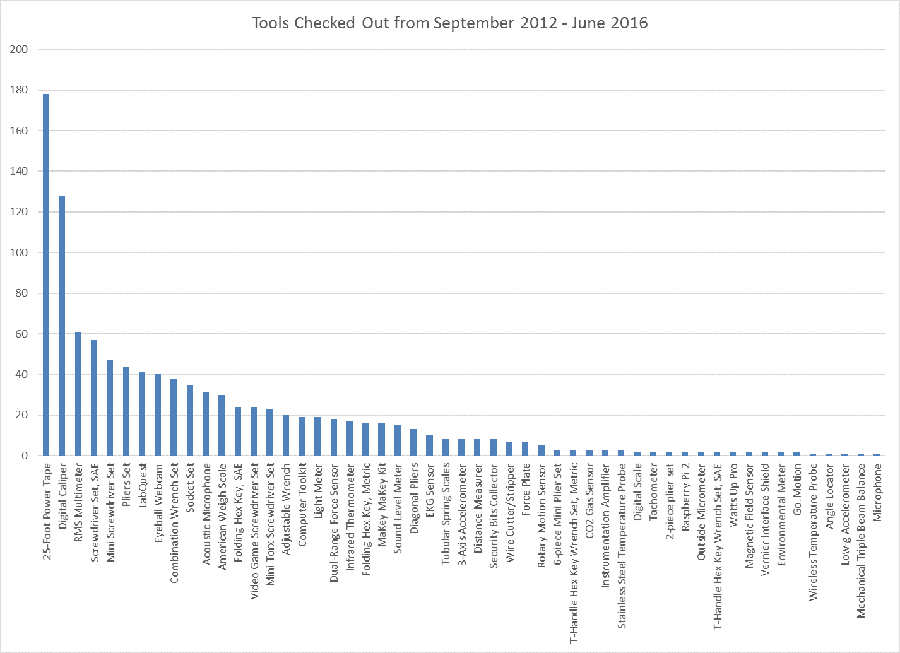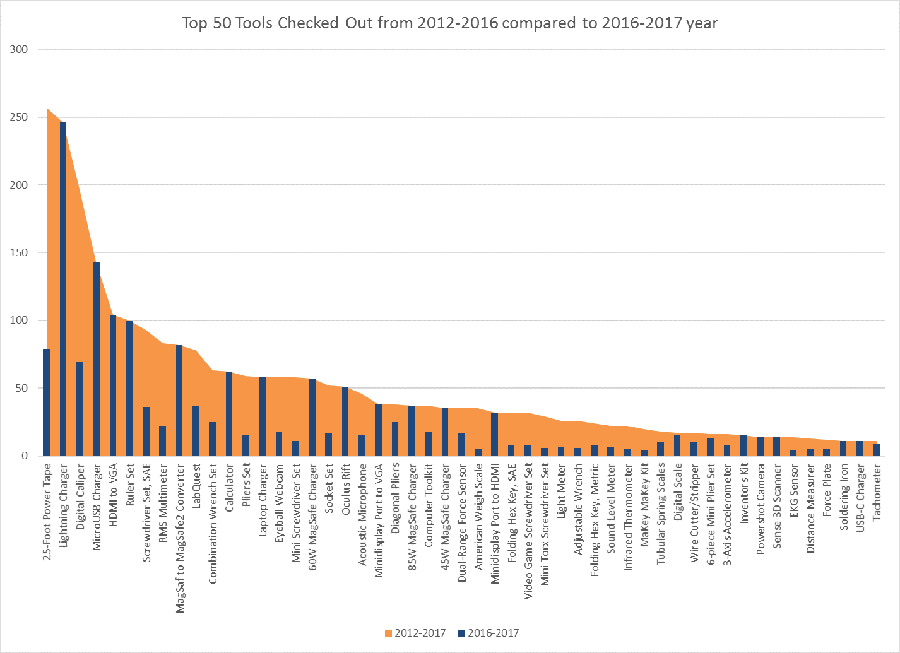There's an App for That
Design, Create, Tinker, Explore, oh my! Creating a Tool Library
Kari A. Kozak
Head, Lichtenberger Engineering Library
University of Iowa
Iowa City, Iowa
Kari-kozak@uiowa.edu
Hands-on learning is a key component of an engineering education. However, students face restrictions if they do not have access to all the tools and resources needed to build, run, and test their experiments. Furthermore, cost can place huge limits on students' ability to play, learn, and tinker. To try and combat these problems, the Lichtenberger Engineering Library collaborated with the College of Engineering to provide free access to the tools and resources needed.
The Tool Library started in 2012 with 38 tools and now has grown to over 150 tools. These range from 25-foot tape measures, digital calipers, and multimeters, to the latest in virtual reality, 3-D scanning and modeling, Arduino programming, and wearable technology. Over the last year, there has been a significant increase in use as more and more high tech tools were made available. Before the beginning of the 2016-17 school year, a new Creative Space was opened within the Engineering Library and the Tool Library was enhanced with 61 tools. The marketing and use in the classroom of the new space and tools increased usage for the year to 1,796 checkouts, which is around a 3% increase over previous years.
Evolution
This whole project began in 2012 with a single conversation when a professor asked if the Library would be open to checking out tools. The professor had tools which he was willing to lend students, but no system for tracking the items. The head librarian was eager to add this new service and set up procedures and a loan policy. (Full policy and procedures can be found at http://www.lib.uiowa.edu/eng/tool-library/.)
The Tool Library started out with 38 items available for checkout and items have been continually added. News of the new Tool Library spread, triggering several different groups and individuals to donate tools.
During the spring of 2016, the head librarian visited several regional university makerspaces to get a feel for what others in the field were undertaking. Discussions focused on creating an interactive space as well as on how the Tool Library might be expanded. Three general themes emerged from these visits and subsequent discussions:
- prototyping (including 3-D scanning and printing)
- virtual reality
- computer programming/circuit building
Taking the information learned during these visits, we combined a small computer classroom and a storage room into a 575-square foot makerspace called the Creative Space. This room is a place for students, faculty, and staff to turn their ideas into reality and to get hands-on experience.
In addition to the new space, the Tool Library was enhanced. Now, not only basic hand- and measuring tools can be checked out, but also more technical items which allow the user to explore the latest in virtual reality, 3-D scanning and modeling, Arduino programming, and wearable technology.
Overview of the Tool Library
The Tool Library now features over 150 tools, available for student, faculty, and staff checkout. Many of the new tools are related to the three central themes of the creative space:
Prototyping
- four types of 3-D scanners
- drawing tablets
- various measuring and hand tools needed to build items from scratch
Virtual Reality
- Oculus Rift headset
- Movio BT-300 augmented reality headset
- leap motion controllers
- 360 degree cameras
Programming/Circuit Building
- a series of creative boxes, created or purchased by the library, providing tools for exploring and testing circuit building
- Raspberry Pi
- Arduino Robot
- Makey Makey cables
- wearable technology
- solderless circuit board with Arduino board kits
All but the virtual reality sets may be checked out for seven days to use within the Creative Space, in class, or to take home.
|
FULL LIST OF AVAILABLE TOOLS Technology Tools: Technology Tools: Oculus Rift (2 hrs.), Movio BT-300 (2 hrs.), Leap Motion controllers, RICOH Theta camera, 360Fly 4K camera, Canon Powershot camera, Sense 3-D scanner, Structor sensor for iPad scanner, Xbox Kinect, acoustic microphone, eyeball webcam, Wacom drawing tablets, adapters, chargers Hand Tools: adjustable wrench, claw hammer, computer toolkit, diagonal pliers, hex key sets (metric & SAE), mini plier set, mini screwdriver set, mini trox screwdriver set, pliers sets, screwdriver set, security bits collector set, socket set, video game screwdriver set, wire cutter/stripper, wrench set Measuring Tools: caliper, digital scale, environmental meter, infrared thermometer, thermal imaging camera, laser distance measurer, level & magnetic angle locator, light meter, micrometer, multimeter (volt meter), pocket grain weight scale, power monitor, sound level meter, tachometer, tape measure, triple beam balance, tubular spring scales, wireless temperature probe Labquest Equipment: LabQuest data collector, 3-axis accelerometer, CO2 sensor, dual-range force sensor, EKG sensor, electrode amplifier, force plate, go! motion, goniometer, instrumentation amplifier, low-g accelerometer, magnetic field sensor, microphone, PH sensor, power amplifier, rotary motion sensor, sound level meter, stainless steel temperature probe, surface temperature probe, thermocouple, watts up pro, wireless dynamics senor system Creative Boxes: MaKey MaKey kit, Raspberry Pi 3 with Vernier Interface Shield, littleBits, Inventor's kit, wearable tech, RedBot Inventor's kit |
Usage Statistics
The addition of the Creative Space and the acquisition of new items in the Tool Library triggered a significant rise in usage statistics. Of the 1,057 items checked out between September 2012 and June 2016, the most popular were the 25-foot tape measure, the digital caliper, pliers set, screwdriver set, and the multimeters (See Table 1). An average of 137 items per semester were checked out during these eight semesters.
Table 1:

On September 8, 2016, the Creative Space opened and 61 items were added to the Tool Library. The new space, marketing, and word of mouth led to a significant increase in the usage of the Tool Library, with 897 items checked out during the fall 2016 semester and 899 during the spring 2017 semester. New items added to the collection accounted for 489 of those items checked out in the fall semester.
To allow for an accurate comparison of usage over time, we took the circulation statistics for items added in 2016 out of the picture, and looked only at tools originally in the Tool Library. We found those original tools accounted for 413 checkouts in fall 2016, which is above the average 137 checkouts of the previous semesters -- around 3% increase in usage.
Since the grand opening of the space was three weeks after the semester began, many of the newer items were not available at that time. Those items were, therefore, only available for roughly 13 weeks. The Oculus Rift, which had a two-hour checkout period and was available only after September 8, was checked out 40 times over the course of the 78 days the library was open during the semester. Table 2 features a chart showing usage of the top 50 tools checked out between September 2012 and May 2017 compared to the usage statistics for the tools from September 2016 to May 2017.
Table 2:

Changes, Improvements, and Upkeep
Over the last four years, both checkout policies and tools have changed to keep up with demand. We have not only changed the checkout policies several times, but have also made improvements to our cataloging system as well.
Currently the majority of tools are available to check out for one week and are searchable within the library catalog. Users now have the ability to add holds and requests for individual tools. We changed the hold policy so the items are only on the hold shelf for three days instead of the usual eight days. This was to allow users quicker access to the tools if they are not picked up from the hold shelf.
When the collection was first created, each tool was put into a clear plastic box, which was barcoded along with a card listing all the items in the box. The boxes were originally labeled A, B, C, etc. with multiple copies cataloged as separate numbers. As the collection has expanded, the tools have been re-cataloged as A1, A2, A3, etc., so multiple copies will all be shelved together. The cables and adapters have been moved out of boxes and are now in cloth bank bags with the Engineering Library logo so they are easier to check out and carry around.
For upkeep, the Lichtenberger Engineering Library has a fund provided by the Engineering Technology Centers to order replacement pieces and batteries. We have had only a few items break over the years -- mostly digital calipers. We are also able to replace batteries through this fund. The costs have not been significant or a hindrance to the program. A few parts of tools have vanished over time, but often extra items have ended up in the boxes or we have found items misplaced in other boxes. Missing pieces have not been a major issue or concern that we have had. We have considered it normal wear and tear.
Keeping up with the latest trends and needs of our student base is another critical part of Tool Library upkeep. We keep a running list of tools which we do not currently have, but which have been requested. These are purchased as extra funds become available.
Impact
The impact of the tool library has been far reaching from classroom integration to use for individual projects. The integration of the Tool Library with classroom projects has been slowly developing over time. The library staff has been invited into several classroom to talk about the space and set up individual tours for group projects. Some of the projects using the tools include:
- Biomedical Engineering class using the goniometer and double force sensors to measure strength and flexibility of joints
- Mechanical Engineering student using a 3D scanner to scan a shoe to design a new style of slip-on grip
- Music professor using a digital caliper to measure the inside diameter of a straw to make a musical instrument
- Art student using the scales and laser measurer to get the dimensions for an art piece she was building
- Electrical and Computer Engineering student checking out the Inventor's kit because he wanted to learn Arduino programming language.
Conclusion
"Creativity, invention, and innovation are values championed as central pillars of engineering education" (Forest et al. 2014). The Tool Library works to foster all aspects of creation and innovation learning and behaviors. The creation and continued expansion of the Tool Library works with many other services offered by both the Engineering Technology Center and the Lichtenberger Engineering Library. Together, they ensure that students can fully explore all aspects of innovation by providing opportunities to tinker, explore, brainstorm, and create.
Acknowledgments
Thank you to the Engineering Technology Center for all their support through this whole process, including John Kostman, Matt McLaughlin, Tom Barnhart, Doug Eltoft, Christopher Fomon, Daniel Mentzer, and Danny Tang.
Thank you to all those at the University of Minnesota (LATIS [Liberal Arts Technologies and Innovation Services], Medical Device Center, Walter Engineering Library, and DigiFabLab [College of Design]), University of Wisconsin - Madison (Wendt Commons [Engineering Library], Garage Physics, and Discovery Building), and University of Illinois - Urbana-Champaign (Undergraduate Library and Granger Engineering Library) for meeting to share your experiences and ideas.
References
Forest, C.R., Moore, R.A., Jariwala, A.S., Fasse, B.B., Linsey, J., Newstetter, W., Ngo, P., & Quintero, C. 2014. The Invention Studio: A University Maker Space and Culture. Advances in Engineering Education 4(2). [Accessed 2017 May 15]. Available from: http://advances.asee.org/wp-content/uploads/vol04/issue02/papers/AEE-14-1-Forest.pdf
| Previous | Contents | Next |

This work is licensed under a Creative Commons Attribution 4.0 International License.
